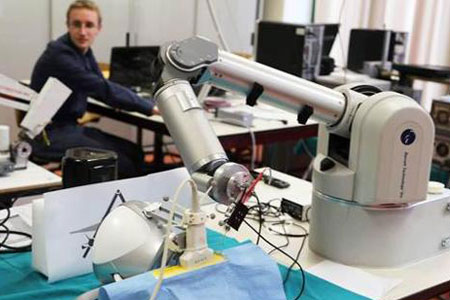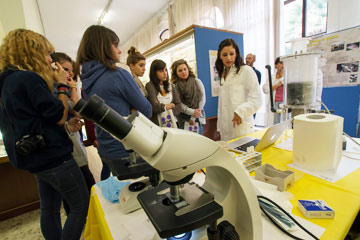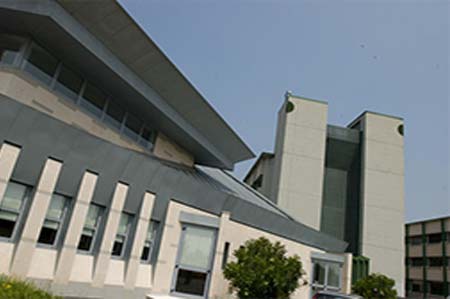|
Computer graphics
standard compliant
ACM 2012
|
| Shape modeling and anlaysis |
Umberto Castellani
|
Shape modelling focuses on the 3D synthesis and simulation of the real world involving geometric, appearance and dynamic aspects (i.e., deforming objects). Shape analysis is based on the processing of 3D structures to infer a higher-level interpretation of the observed data using for examples shape matching or shape segmentation techniques. Recent advances in this field encompass deep learning methods on the 3D domain (i.e., geometric deep learning). |
|
Computer vision
standard compliant
ACM 2012
|
| Biometrics |
Cigdem Beyan
Vittorio Murino
|
Advancing face, fingerprint, and iris recognition, as well as gait analysis, voice biometrics, and multimodal biometric systems. It also addresses privacy and ethical considerations in biometric applications. |
| Medical image processing |
Cigdem Beyan
Vittorio Murino
|
Developing techniques to process and interpret medical images, including those from modalities like X-rays, CT scans, MRIs, and histopathology slides. Applications include disease diagnosis, tissue segmentation, organ recognition, anomaly detection, and treatment monitoring. By leveraging deep learning and advanced image processing, medical computer vision enhances diagnostic accuracy, supports personalized treatment, and enables real-time insights in healthcare settings. |
| Activity recognition and understanding |
Cigdem Beyan
Vittorio Murino
|
Recognizing and understanding individual and group activities, including gaze tracking, facial expression analysis, and human-object and social interaction analysis, with applications in healthcare, assisted living, and public safety. |
| Video surveillance and monitoring |
Cigdem Beyan
Vittorio Murino
|
Detecting anomalies in surveillance footage, identifying events and generating alerts, tracking objects, and analyzing motion. It has applications in smart cities, transportation, and retail environments. |
|
Distributed artificial intelligence
standard compliant
ACM 2012
|
| Intelligent agents |
Alberto Castellini
Matteo Cristani
Luca Di Persio
Alessandro Farinelli
Daniele Meli
|
Design and development of autonomous entities that can sense, model and interact with the environment in which they operate. These area focuses on the interaction and integration of solution technques for several research topics such as automated planning and reasoning, reinforcement learning, statistical learning and reasoning in face of uncertainty. |
| Multi agent systems |
Alberto Castellini
Matteo Cristani
Luca Di Persio
Alessandro Farinelli
|
Design and development of multiagent systems, where intelligent agents can interact among them, with the environment and with humans. This area focuses on the interaction and integration of solution techniques related to multiagent planning, statistical learning, multi-agent reinforcement learning and game theory. |
|
Human computer interaction (HCI)
standard compliant
ACM 2012
|
| Affective Computing |
Cigdem Beyan
Vittorio Murino
|
Focuses on designing systems that can detect, interpret, and respond to human internal states, including emotions, moods, motivations, and cognitive states as well as subtle cues like stress, attention levels, and engagement, using inputs from facial expressions, voice tone, physiological signals, and contextual behavior. The aim of affective computing is to enable technology to interact more naturally and empathetically, adapting responses based on a user’s inner state to improve user experience and engagement. |
| Social AI (Social signal processing) |
Cigdem Beyan
Vittorio Murino
|
Developing AI systems that can perceive, interpret, and respond to human social behaviors and interactions. This field combines knowledge from computer vision, multimedia, psychology, linguistics, and machine learning to enable machines to understand social signals, such as facial expressions, gestures, gaze, voice intonation, and body language. The aim is to create systems capable of engaging in socially aware interactions, recognizing human intentions and social dynamics, and adapting responses accordingly. |
|
Knowledge representation and reasoning
standard compliant
ACM 2012
|
| Automated reasoning |
Maria Paola Bonacina
Matteo Cristani
|
Decision procedures for satisfiability modulo theories and assignments; Automated theorem proving; Automated model building; Reasoning about programs; Interpolation of proofs for the generation of abstractions or explanations; Strategy analysis; Distributed automated deduction; Rewriting. |
| Temporal reasoning |
Roberto Posenato
|
Temporal constraint networks are a research area within temporal reasoning focused on modeling and solving problems where events, tasks, or resources are constrained by temporal dependencies. Temporal constraint networks are used to tackle complex problems in scheduling, planning, and coordination, especially in dynamic environments where constraints may evolve over time. Recent advancements incorporate game-theoretic models, spatio-temporal constraints, and probabilistic methods to address the challenges posed by time-varying, decentralized, and uncertain systems. |
| Knowledge representation |
Matteo Cristani
|
Reasoning with knowledge; non-monotonic reasoning; reasoning with spatio-temporal constraints; defeasible logic. |
|
Machine learning
standard compliant
ACM 2012
|
| Active learning |
Cigdem Beyan
Manuele Bicego
Ferdinando Cicalese
Rosalba Giugno
|
In active learning, the model iteratively queries an oracle (typically a human annotator) to label only the most informative data points that would contribute most to improving the model's accuracy. By doing so, active learning reduces the labeling cost and accelerates the model's learning process. This approach is particularly useful when labeled data is scarce or expensive to obtain. The research focuses on developing effective selection criteria to identify the most informative data points for labeling, thereby improving the efficiency of the active learning process. |
| Domain adaptation/generalization |
Cigdem Beyan
Vittorio Murino
|
Refers to techniques in machine learning that aim to improve the performance of models when applied to new, unseen domains or environments. Domain adaptation focuses on transferring knowledge learned from a source domain (with abundant labeled data) to a target domain (with limited or no labeled data), overcoming the distributional differences between the two. On the other hand, domain generalization aims to develop models that can generalize across multiple domains, making them robust to variations without needing to retrain them on each specific domain. These approaches are particularly important in real-world applications, where models must perform reliably across diverse and changing datasets. |
| Multi-modal Learning |
Cigdem Beyan
Vittorio Murino
|
Aims to integrate and analyze data from multiple sources or modalities, such as images, text, audio, and video, to improve the performance and understanding of machine learning models. By combining information from different types of data, multi-modal learning enables systems to better capture the richness and complexity of real-world information. This field includes challenges such as modality translation, alignment, fusion, effective representation, and more. This area also includes multimodal/visual language models such as CLIP, which connects text and images, DALL-E, which generates images from text, BLIP, designed for image captioning and visual question answering, and large language models like GPT-4 and LLaMA, which extend to multimodal functions for tasks like text-to-image generation. |
| Multi-task learning |
Cigdem Beyan
Vittorio Murino
|
A paradigm where a model is trained to solve multiple related tasks simultaneously, sharing knowledge and representations across tasks to improve overall performance. Instead of training separate models for each task, multi-task learning leverages shared features and parameters, allowing the model to learn generalized representations that benefit all tasks involved. Research in this field focuses on improving task prioritization, balancing task importance, designing more efficient architectures, and dealing with negative transfer—where learning one task harms the performance of others. Additionally, the exploration of methods for task weighting, shared and task-specific layers, and transfer learning techniques are actively being investigated to enhance the versatility and scalability of multi-task models. |
| Unsupervised learning |
Cigdem Beyan
Manuele Bicego
Alberto Castellini
Ferdinando Cicalese
Alessandro Farinelli
Rosalba Giugno
Vittorio Murino
|
Is an approach where models are trained on unlabeled data, with the goal of identifying hidden patterns or structures within the data without predefined labels. It is commonly used for tasks like clustering, dimensionality reduction, and anomaly detection. Open research in unsupervised learning focuses on improving the ability to discover meaningful structures in complex, high-dimensional datasets, often with limited prior knowledge. Key challenges include developing more effective clustering algorithms, improving the interpretability of models that uncover latent structures, and handling high levels of noise or sparsity in data. Additionally, there is ongoing work to bridge the gap between unsupervised learning and other paradigms, such as semi-supervised, self-supervised or contrastive learning, and to enhance the robustness of unsupervised models in real-world applications. |
| Reinforcement learning |
Alberto Castellini
Alessandro Farinelli
|
Reinforcement Learning (RL) is a learning paradigm where agents to learn how to take a sequence of decisions through interactions with their environment. RL trains a model by considering a reward signal that is associated with the actions performed in the environment (high reward for good actions and the opposite). The model aims at optimizing the expected accumulated reward over time. RL is very intersting for practical applications (e.g., robotics, recommender systems) because it requires minimal specifications from the user and it can adapt to unpredicatble changes in the enrvironment. Main challenges relates to devising safe policies for the agents, e.g., learning while avoiding catastrophic falures (safe reinforcement learning and offline reinforcement learning), to properly evaluate the quality of a trained system, e.g., how can we guarantee that the agent will behave properly in unseen situations, and to improve sample efficiency, e.g., model-based reinforcement learning. |
| Semi-supervised learning |
Cigdem Beyan
Vittorio Murino
|
Combines a small amount of labeled data with a large amount of unlabeled data during training. The goal is to leverage the abundant unlabeled data to improve the learning process, using the limited labeled data to guide the model’s understanding of the task. This approach is particularly useful in scenarios where labeling data is expensive or time-consuming, but there is a large pool of unlabeled data available. |
| Supervised learning |
Cigdem Beyan
Manuele Bicego
Alberto Castellini
Ferdinando Cicalese
Alessandro Farinelli
Rosalba Giugno
Vittorio Murino
|
Is an approach where models are trained on labeled data to learn a mapping from inputs to outputs, enabling them to predict correct labels for new, unseen data. While widely used for tasks like classification, regression, and time series forecasting, open research in this field addresses several challenges. Key questions include how to make models more robust to label noise and inconsistencies, improve sample efficiency to reduce the need for large labeled datasets, and enable effective transfer learning across different tasks and domains with limited labeled data. Additionally, addressing issues of fairness and bias in supervised models, as well as improving scalability to handle large datasets without compromising performance, and attention/transformer-based approaches remain active areas of exploration. |
| Deep learning |
Cigdem Beyan
Alberto Castellini
Alessandro Farinelli
Rosalba Giugno
Vittorio Murino
|
Focuses on training neural networks with multiple layers to automatically learn patterns and representations from large amounts of data. Using architectures such as convolutional neural networks (CNNs) for images, recurrent neural networks (RNNs) for sequential data, and transformers for diverse tasks, deep learning excels at complex tasks like image recognition, natural language processing, speech recognition, reinforcement learning, time series analysis, and autonomous driving. |
| Explainable artificial intelligence |
Alberto Castellini
Alessandro Farinelli
Daniele Meli
|
The goal of explainable AI (XAI) is to i) explain black-box models; ii) develop AI models which are interpretable by construction. For instance, this involves causal analysis and discovery, logical models of agency (with logic programming) and logical machine learning (with inductive logic programming). XAI helps characterize model accuracy, fairness, transparency and outcomes in AI-powered decision making; moreover this field focuses on methods for improving model and decision interpretation using statistical and graphical tools. |
|
Natural language processing
standard compliant
ACM 2012
|
| NLP and LLM |
Matteo Cristani
|
Technologies for undestanding and generating texts; specific text processing, in particular legal texts; generation of texts including artificial languages ones. |
|
Planning and scheduling
standard compliant
ACM 2012
|
| AI & robotics |
Alberto Castellini
Alessandro Farinelli
Daniele Meli
|
Application of AI techniques to increase the autonomy level of robotic systems. This includes the adaptation of algorithms for autonomous planning and reinforcement learning to: i) handle the cyber-physical constraints imposed by robots operating in partially observable and uncertain scenarios; ii) guarantee the reliability and robustness of robotic systems that operate in open environments (e.g., interacting with humans and other robotic systems); iii) facilitate the use of robotic systems in realistic application by proposing novel paradigms of interaction with users (e.g., train a robot to execute a task rather than specify a control program). |
| Planning under uncertainty |
Alberto Castellini
Alessandro Farinelli
|
Planning under uncertainty focuses on sequential decision-making in uncertain environments, namely, situations with imperfect information. (Partially Observable) Markov Decision Processes are used to represent these contexts. The goal of planning under uncertainty is to generate optimal policies for these problems, namely, functions able to suggest optimal actions in situations faced by the agent. The main challenges concern dealing with large problems (scalability), acquiring new knowledge about the environment (adaptability), preventing undesirable behaviors (safety), safe policy improvement (robustness), interacting with humans (human-in-the-loop), supporting human understanding (explainability), bridging planning and reinforcement learning (model-based RL), bridging symbolic and probabilistic/data-driven planning. Among the most recent approaches to tackle these challenges, online methods based on Monte Carlo Tree Search have achieved strong results in the last years in both strategic games (e.g., board games such as Go) and real-world applications (e.g., robotics, cyber-physical systems, and decision support systems). |
| Multi-agent planning |
Alberto Castellini
Alessandro Farinelli
|
Multiagent planning deals with planning approaches applied to multi-agent systems. The main goal of these techniques is to generate solutions for sequential decision making that promote synergy among multiple autonomous agents to achieve collective goals. Among the main topic of this field there are decentralized optimization, multiagent path planning, multiagent learning, cooperation and coordination. Important tools in this fiels are, for instance, coordination graphs that are used in recent cooperative multi-agent planning and reinforcement learning (MARL) algorithms where coordination between agents is essential to accomplish the task. Coordination graphs allow to represent how agents can coordinate using some communication via message passing. Applications of multiagent planning span over a wide set of domains including autonomous driving, logistic (e.g., fleet of autonomous robots), environmental monitoring (fleet of mobile drones for data acquisition). |
| Neurosymbolic planning |
Alberto Castellini
Alessandro Farinelli
Daniele Meli
|
Neurosymbolic AI focuses on combining standard data-driven AI (e.g., reinforcement learning) with symbolic approaches (e.g., logic programming and inductive logic programming), in order to enhance the explainability of AI systems (e.g., autonomous agents), their efficacy in human-robot interaction, and foster incremental knowledge acquisition and generalization in planning. |







